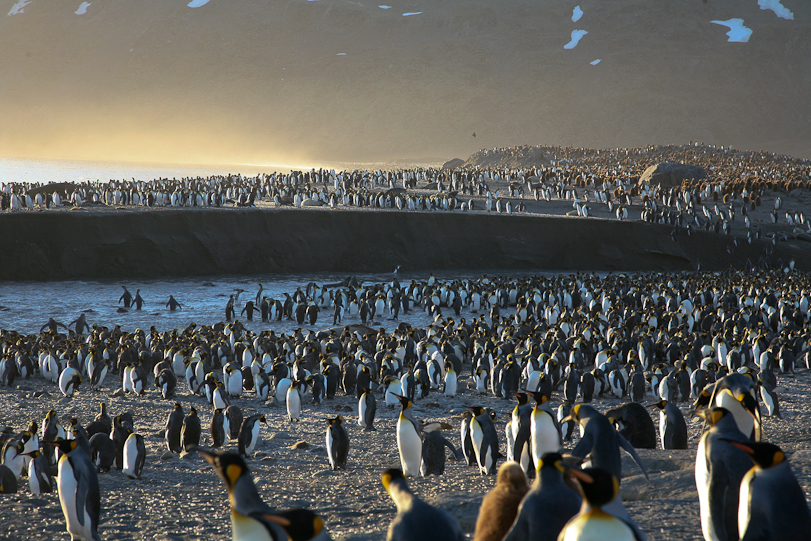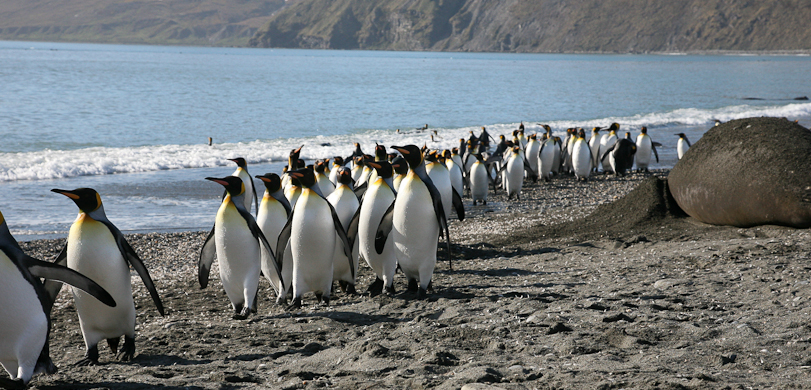
St Andrew's Bay also faces east, so we had another pre-dawn landing. With fewer takers this time, only 60 or so, rather than the 90 + who rallied round yesterday (rather to the surprise of the staff – but we are a dedicated bunch on this trip). This made it rather less crowded on the beach, and it was again fair and calm, though quite cold as we waited for the “magic moment” -- that is, the few minutes before the sun actually rises, when the light is perfectly soft, with no shadows, when it paints every surface in magical colors. The NG photographers assure us that this is the time during which virtually all published pictures are shot.
This bay is also home to a King Penguin colony – in this case, the largest one on South Georgia, with hundreds of thousands of pairs. As we waited, listening to the snorting of the Elephant Seals (and trying to keep an eye on the big bull lying next to us), the light grew slowly and began to reveal to us what this means. The at last the glaciers began to glow, and frozen fingers began clicking madly to capture slices of the scene before us as it changed from moment to moment. The NG photographers next to us were totally engrossed – this is what they live for, this is why they, and we, have come, to be here in this place at this precise moment.

After the big event we wander down the beach and begin to appreciate the vastness and complexity of the huge breeding colony. The Kings have an odd cycle, which takes about 17 months, so there are birds in all stages (except eggs, at least we didn't see any). Many are molting adults, preparing their breeding plumage, and many more are chicks nearing adulthood and shedding their brown wooly layer in peculiar and comical ways. This mean the place is carpeted in penguin down, like snow drifts in places. It coats everything, including the Elephant Seals; it is thick in the gentle surf. I even saw a skein of feathers float by the dining room window at breakfast, between the porpoising penguins.
The beach itself is a wonderful place to sit. Lines of penguins march out to sea to feed, while the waves bring in rafts of penguins coming back to their chicks. They all thread their way through the Elephant Seals and make their way back into the depths of the colony.

As we follow them back, we begin to see the huge clumps of brown chicks, the “oakum boys.” The penguins are swimming up and down in the river from the glacier, and line it on both sides as far as you can see, and if you go up this ridge, the other side is all penguins out to the horizon. It is mind-boggling, beyond imagination. And being in it, in the middle of it, hearing and seeing and smelling it all around you is nothing at all like seeing it in the National Geographic special. If you sit still anywhere, a curious chick will come up to check you out. Or it might be a group of adults (they are like teenage girls, they seem to travel in clumps). We take hundreds of pictures, but despair of actually getting any of it across.

As we fall into the parade of red coats filing up the beach to catch the last zodiac to lunch, we feel that we are at one with the penguins, marching out to the sea to feed.
And now for something completely different...
We are told that Hercules Bay has a narrow opening into a nearly circular bay surrounded on all sides, and is thus very protected from wind and weather. Since the sky is still this very improbable blue, that means a very good chance of kayaking, which many folks still want to do. Thinking that kayaking was the major motivation for the site, we are first pleasantly surprised, and then downright astonished to find ourselves floating amid cliffs rising nearly vertically from the water all around us, with vast glaciers hanging from them in every direction, long rushing waterfalls, water curtains dripping over cave fronts.
There are no landings here, only tiny beach strips big enough for a half-dozen seals. We are in the second zodiac group, and as we look down on the kayaks and zodiacs of the first group, we seem them gazing raptly at white dots on the steep and rocky moss-covered cliffs. A closer look through the binoculars reveals Macaroni Penguins, hopping out of the sea onto jagged rocks, inexplicably making their way nearly straight up to their nests high above, using only their little short legs and powerful clawed feet.
When it is our turn, we also gaze up to follow the progress of the penguins at close range. The lovely Grey-mantled Sooty Albatrosses nest here as well. We discover rocks and small ledges populated with Fur Seals, including playful youngsters, last year's pups. The water around the edges is full of Razor-strop Kelp, very aptly named; the long leathery flat (leaves? vines?) look and feel just like razor strops. They all line up together into an undulating mass that looks like some kind of kinetic op art.
We get a call from the ship to bring in the boats for any guest who would like to do the polar plunge – that is, jump into the freezing water from the zodiac loading platform. Incredibly, one of our party wishes to do so. No surprise who that is, our friend from the bridge and the bow signs up for every long hike and steep climb. We elect to stay in the boat and document the experience.
As we sail out of this beautiful bay, the fog lies across the entrance. I expect this is the end of our need for sunscreen on this voyage.